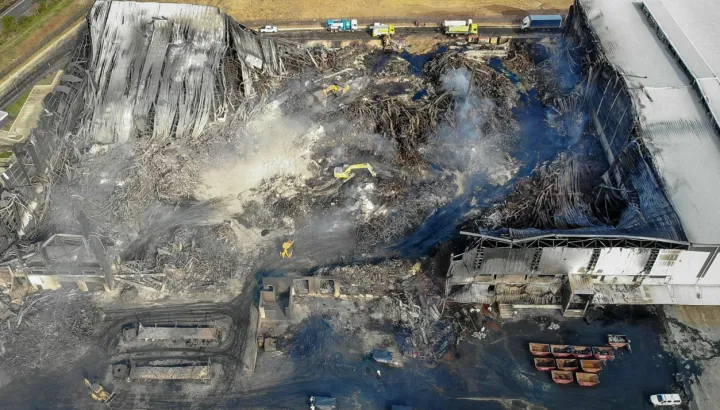RIGHT OF REPLY
Report on UPL Cornubia warehouse fire lacks contextual knowledge and understanding of a scientific field

Readers should trust the experts on the impact of the arson fire on the environment and human health – UPL
The article “Why is UPL still sitting on dioxin analysis tests 10 months after Cornubia fire?” by Tony Carnie (Daily Maverick, 26 May 2022) refers.
Mr Carnie makes a number of deductions in this article from detailed responses provided to him by the specialist team appointed by UPL to drive monitoring, mitigation and remediation efforts following the arson attack on its Cornubia warehouse during the KwaZulu-Natal riots in July last year. However, the majority of his assumptions are problematic and simply serve to highlight that in the lack of formal qualifications (in toxicology, epidemiology or chemical engineering, for example) “community science” can often lack the experience or real understanding of the subject matter needed to contextualise such information in an accurate manner.
The article opens with an overly simplistic and flawed comparison between last year’s Cornubia warehouse fire and the explosion at a chemical plant in Seveso, Lombardy, Italy, in 1976 that was owned by pharmaceutical giant Roche.
The first problem with this comparison is the fact that what occurred at the Seveso chemical plant was an exothermic reaction which raised the temperature and pressure inside a reactor used for TCP production beyond its limits. This runaway reaction caused a safety device to blowout.
This distinction is important with regard to the temperatures that would have been reached in the Seveso incident versus the Cornubia warehouse fire, and what these temperatures (as well as the duration) meant for the formation of dioxins.
Higher temperature combustion processes, in excess of 500ºc, produce much lower dioxin amounts (as was the case in the flaming phase of UPL Warehouse fire). In the Seveso incident, temperatures were more in the range of between 200°C and 400°C as the reactor eliminated first ethylene glycol, and then diethylene glycol. The Seveso blowout is also an event which happened over a much shorter duration, not just at lower temperature. A further and important distinction is that 2,3,7,8-tetrachlorodibenzo-p-dioxin (TCDD) was already present in the reactor. TCDD was a byproduct in the reaction process. It may be speculated there was even an increased production above the ‘normal reaction’ during the period when the temperature was between 250°C and 400°C.
In contrast, a fire, as in the case of the Cornubia incident, is a much slower event with heat building up more gradually but reaching far higher temperatures of close to 900°c, which results in much longer and more effective combustion of organic substances. As a result, the possibility of dioxins forming during this intense heat event would have been far lower than what would have been formed during the Seveso explosion.
In fact, the Seveso incident saw the release of an aerosol cloud that included sodium hydroxide, ethylene glycol, sodium trichlorophenate, and an estimated 15kg to 30 kg of 2,3,7,8-tetrachlorodibenzo para dioxin (TCDD or what is commonly known as dioxins) into the air while no such dioxins were released during the UPL warehouse fire.
The Seveso explosion is still considered the world’s largest contamination of soil and buildings. It is also pertinent because the event was the catalyst for the establishment of benchmarks for dioxin levels. As part of the clean-up and rehabilitation efforts in the area at the time, the Lombardy regional authorities established the maximum permissible TCDD (dioxin) levels that would be considered safe in the soil and exterior and interior building surfaces. These were below 5 µg/m²; in the 7cm topsoil layer, below 0.75 µg/m² in exterior building surfaces and below 0.01 µg/m² on interior surfaces.
This was followed in 1998, by the United States Environmental Protection Agency (EPA) issuing a directive setting the Preliminary Remediation Goal (PRG) for dioxins in residential soil at 1,000 ng-TEQ/kg. While there was a subsequent proposal by the EPA in 2010 to reduce the PRG to 72 ng-TEQ/kg for residential soils and 950 ng-TEQ/kg for commercial/industrial soils.
With these permissible levels in mind, let’s turn to what testing of air and soil samples during the Cornubia warehouse fire picked up when it comes to the presence of dioxins. Contrary to claims made by the article, the specialist team has conducted extensive sampling of air, soil and water during and after the fire and has tested for a large suite of substances including the presence of dioxins and other low concentration-high toxicity substances.
The analytical results were interpreted by specialists and the conclusions are available in the public domain. This includes the atmospheric impact report (AIR) compiled by independent specialist company Airshed Planning Professionals, which estimated that the maximum levels of dioxins (within 500m of the fire) would have been up to 0.011 µg-TEQ/m², which is considerably lower than the maximum permissible levels set by the Lombardy regional government after the Seveso incident. Furthermore, soil samples collected by independent specialist firm Skyside revealed that the highest concentrations of dioxins reached about 2 ng-TEQ/kg, which is not only way lower than the reported soil concentrations of 20,000 ng/kg following the Seveso accident but also considerably lower than the criterion set by the Lombardy regional authorities and the United States EPA.
What is also worth noting is that analysis of the dioxin testing results suggests that there is no connection between the levels of dioxins found and the fire at the leased UPL warehouse. Specifically, the distribution pattern is not consistent with the predominant deposition array anticipated by the dispersion model, the wind direction or the complaints, suggesting the limited dioxins that were identified are not clearly linked to the warehouse fire. In addition, there was no TCDD detected in any of the samples.
However, perhaps the clearest indication that there is a lack of contextual knowledge and understanding of this scientific field is the assumption that the presence of any level of dioxins in the air or the soil is dangerous and a threat to human health. The fact is that because dioxins are a byproduct of combustion, a dioxin-free world would be impossible to achieve.
Emissions of dioxins are common from rubbish-burning incinerators, garden bonfires, forest fires and even the family fireplace or barbeque. The French environmental group Robin des Bois evaluated the fumes associated with the two-hour grilling of four steaks, four turkey cuts and eight sausages over a barbecue, and counted far greater doses of dioxins than would be permissible at the outlet of a commercial incinerator chimney. In fact, the dioxin levels approached those associated with smoking 20,000 cigarettes.
When it comes to the average levels of dioxins found in soil, samples taken in the Northwest and Free State provinces in 2009, found dioxin levels ranging from 0.34 ng-TEQ/kg to 20 ng-TEQ/kg, with soils from the industrial area of Vanderbijlpark and the residential area of Klerksdorp containing the greatest concentrations. This is far higher than the highest concentrations of dioxins reached (2 ng-TEQ/kg) in soil samples taken in close proximity to the Cornubia warehouse fire.
The article’s comparison of the pesticides stored in the UPL warehouse to the dioxin-containing agent orange used by the United States to defoliate plants in Cambodia and Vietnam is also unfortunately disingenuous and alarmist. The fact is that all the pesticides stored in the Cornubia warehouse were proprietary products approved for use in South Africa by the Health Department and by the Department of Agriculture in terms of Act No.36 of 1947. These products were developed through modern synthetic processes by reputable manufacturers in which dioxin levels are close to undetectable.
These facts, along with the nature of the fire last year and the results of testing during and after the incident are why the team of specialists have concluded that it was of low consequence and that its impact on the environment and human health was low.
These conclusions have been further supported by the occupational health clinic established by UPL in conjunction with health authorities in Umdloti where surrounding communities and complainants have been invited for a health assessment. It appears from both the testing of first responders and on-site personnel and those who have attended the clinic, that there are very few, if any, chronic health impacts attributable to the fire or spill.
Furthermore, as a result of UPL’s extensive clean-up efforts, the environment surrounding the warehouse site has shown remarkable recovery with revegetation trials that commenced in January 2022 already proving successful.
It is unfortunate, that despite the extensive amount of detail provided by UPL and its team of specialists in the past, this article includes only some information without the full context resulting in a flawed picture of the real impact of the warehouse fire and resultant chemical spill as well as UPL’s extensive efforts to clean up and rehabilitate the area after the incident. DM
Vicki King is Metamorphosis Environmental Consultants coordinator.
This response was drafted with input from a panel of independent specialists.
Tony Carnie’s footnote
On page 77 of the Air Impact Report, Dr Lucian Burger appears to indicate that the computer modelling dispersion simulations were based on the assumption that the flame temperature was 1,000°C.
It would be useful to clarify whether this assumption for modelling purposes applied to the full eight-day duration of the fire (both the initial peak period of the fire and the longer smouldering phase at lower temperatures). This is important because, as Dr Burger acknowledges in the same report, dioxin emissions are significantly lower when chemicals burn at very high temperatures (above 950°C) — while dioxin emissions are significantly higher when burned at lower temperatures.
As he states in the report, the fire went through four different phases, which included significantly lower temperatures and incomplete combustion during the lengthier smouldering phase.
In regard to the sampling and analysis of toxic emissions, UPL has stated that its consultants have collected and analysed “thousands” of samples of various chemical compounds. Curiously, however, only six soil samples appear to have been analysed specifically for PCCD/PCCF (dioxins and furans).
We have requested copies of the dioxin analysis laboratory certificates from UPL, but these were not provided. If there is nothing to hide, why not play open cards with the public by releasing those certificates? And, considering the high potential health risks, why not analyse a larger number of samples for dioxins to provide a high level of assurance that a robust process has been followed to safeguard public health?
Extract from Dr Lucian Burger’s report:
[hearken id=”daily-maverick/9419″]






















 Become an Insider
Become an Insider
Comments - Please login in order to comment.